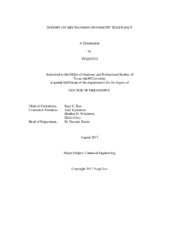| dc.description.abstract | Industrial biotechnology provides a sustainable and environmentally sound way to produce chemicals by using renewable raw materials. Sustainability of industrial biotechnology can be further improved if alternative water sources such seawater and wastewater can be utilized instead of freshwater in fermentation. However, one of the challenges in the microbial production of chemicals is the low tolerance of the host to inhibitors present in the feedstocks and the alternative water sources, which inhibits the widespread of their usage. Thus, strain development with desired phenotypes is needed to expand the utilization of the renewable feedstocks and the alternative water sources. However, poor understanding of the mechanisms for most complex traits, such as tolerance to inhibitors, pose a major challenge to rational strain development for more robust host producers.
In this dissertation, a focus is made on developing microbial hosts with increased tolerance to osmotic stress, specifically sodium chloride (NaCl). This dissertation begins with the validation of the osmotic tolerance of an rpoC mutation which has been identified in separately evolved osmotolerant mutants of Escherichia coli. Using a combination of single amino acid supplementation, metabolites quantification, membrane stability and global transcriptional analysis, we found that the osmotic tolerance conferred by this rpoC mutation may be related with higher production of acetic acids and amino acids, increased membrane integrity, upregulation of genes metK and mmuP, and downregulation of a stress related gene bolA. The next section describes the utilization of seawater to improve the production of carotenoids in Saccharomyces cerevisiae. The NaCl supplementation tests and lipid analysis demonstrated that the carotenoids production improvement in seawater is partially related with additional NaCl presented in seawater and may also related with lipid content and composition. The following section describes the improvement of osmotic tolerance and growth of Saccharomyces cerevisiae strain SM14 in seawater via adaptive laboratory evolution, and we identified mutations in WHI2 that confer the improved osmotic tolerance in SM14. In conclusion, these findings expanded our current understanding of osmotic tolerance in E. coli and S. cerevisiae, and have the potential to expand the utilization of high saline feedstocks and water sources in microbial fermentation. | en |


